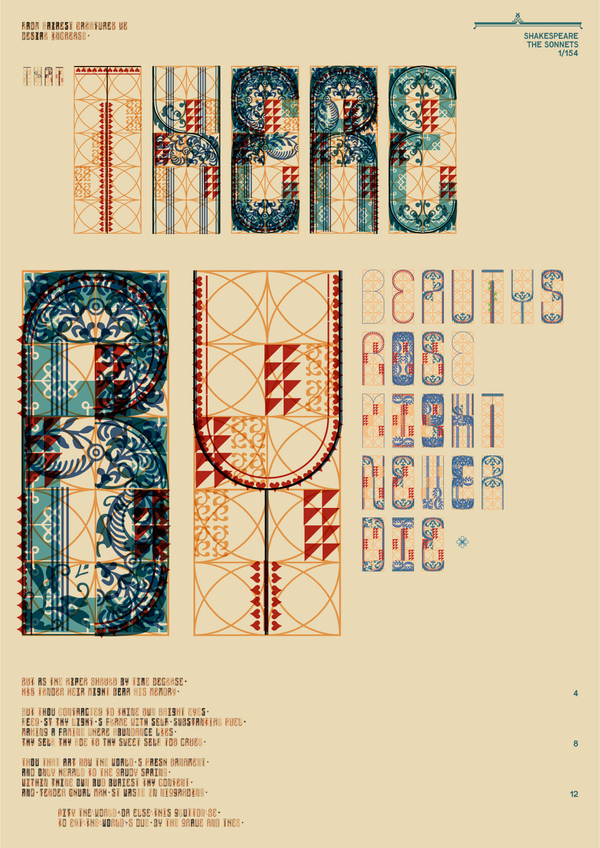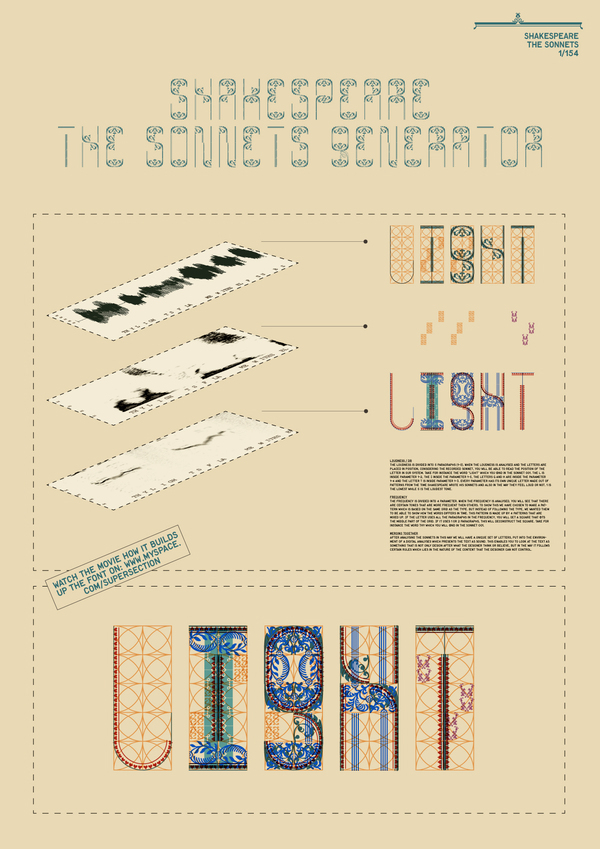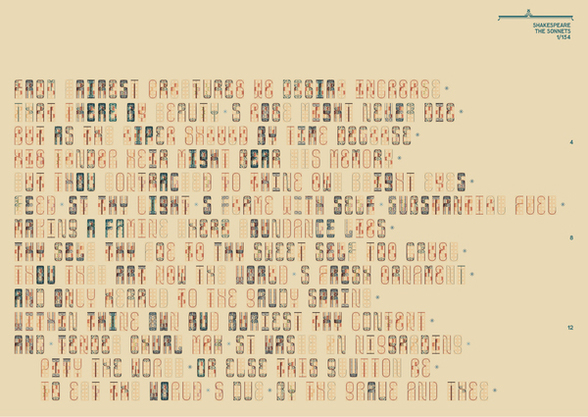

Poster explaining how our system works.

Description:
A type experiment made together with Simon Egli (Zurich).
Allpatterns used in the experiment are taken from books that whereproduced in the same period of Shakespeare. Borrowed from the BritishLibrary.
After buying a CD with all the Shakespeare sonnets we imported the sound files into a program where you can take out all information from the sound and make parameters/rules out of them.
By using the parameters we get a set of rules that our type would follow. And the end result is not controlled by us as designers, but by the set of rules that we set up.
Explanation of the process:
LOUDNESS / DB: The loudness is divided into 5 paragraphs (1-5). When the loudness is analysed and the letters are placed in position, considering the recorded sonnet, you will be able to read the position of the letter in our system. 1 is the lowest while 5 is the loudest tone
Take for instance the word “light” which you find in the sonnet 001. The L is inside parameter 1-2, the I inside the parameter 1-5, the letters G and H are inside the parameter 1-4 and the letter T is inside parameter 1-3.
FREQUENCY: The frequency is divided into 4 parameters. When the frequency is analysed, you will see that there are certain tones that are more frequent then others. To show this we have chosen to make a pattern which is based on the same grid as the type. but instead of following the type, we wanted them to be able to show how the words differ in time.
This pattern is made up by 4 patterns that are mixed up. If the letter uses all the paragraphs in the frequency, you will get a square that fits the middle part of the grid. If it uses 1 or 2 paragraphs, this will deconstruct the square. Take for instance the word THY which you will find in the Sonnet 001.
MERGING: After analysing the Sonnets in this way we will have a unique set of letters, put into the environment of a digital analyses which presents the text as sound. This enables you to look at the text as something that is not only design after what the designer thinks or believes, but in the way it follows certain rules which lies in the nature of the content that the designer can not control.
Allpatterns used in the experiment are taken from books that whereproduced in the same period of Shakespeare. Borrowed from the BritishLibrary.
After buying a CD with all the Shakespeare sonnets we imported the sound files into a program where you can take out all information from the sound and make parameters/rules out of them.
By using the parameters we get a set of rules that our type would follow. And the end result is not controlled by us as designers, but by the set of rules that we set up.
Explanation of the process:
LOUDNESS / DB: The loudness is divided into 5 paragraphs (1-5). When the loudness is analysed and the letters are placed in position, considering the recorded sonnet, you will be able to read the position of the letter in our system. 1 is the lowest while 5 is the loudest tone
Take for instance the word “light” which you find in the sonnet 001. The L is inside parameter 1-2, the I inside the parameter 1-5, the letters G and H are inside the parameter 1-4 and the letter T is inside parameter 1-3.
FREQUENCY: The frequency is divided into 4 parameters. When the frequency is analysed, you will see that there are certain tones that are more frequent then others. To show this we have chosen to make a pattern which is based on the same grid as the type. but instead of following the type, we wanted them to be able to show how the words differ in time.
This pattern is made up by 4 patterns that are mixed up. If the letter uses all the paragraphs in the frequency, you will get a square that fits the middle part of the grid. If it uses 1 or 2 paragraphs, this will deconstruct the square. Take for instance the word THY which you will find in the Sonnet 001.
MERGING: After analysing the Sonnets in this way we will have a unique set of letters, put into the environment of a digital analyses which presents the text as sound. This enables you to look at the text as something that is not only design after what the designer thinks or believes, but in the way it follows certain rules which lies in the nature of the content that the designer can not control.
